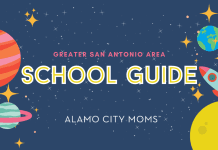September is a great time to start looking for the right school for your child to attend a year from now. Really? Yes. If you are looking beyond your neighborhood public school, the fall is a great time to do research, visit schools, and plan your application strategy. With advance knowledge, you can make the most of school tours and ask questions that will help you find out whether a school is the right fit.

Application Timeline
How to enroll your child in school depends on the type of school: it’s a different process for traditional public schools, public charter schools, magnet schools, and private schools.
Your local school district has to find a place for your child no matter when you enroll, even if it’s in the middle of the school year. If you live in a fast-growing area and your local campus is overcrowded, your child might get assigned to a different campus, but the district should still provide transportation. School districts often hold open houses in the spring and registration fairs in the spring and summer. Registering early helps you learn about what’s going on in the district and find opportunities to meet friends and get involved. When you moved into your house or apartment, your realtor probably told you what school district you were in; Greatschools.org also has easy search tools. Check with your local school district to find out what kind of paperwork (e.g., utility bills) they need as proof of residency.
Public charter schools are tuition-free and can enroll students from a wide geographic area, but they have a limited number of seats and use a lottery system to fill them. Once a grade level is full, the school will start keeping a waiting list. The best time to apply is during the open enrollment period, typically in the winter or spring. All of the applications received during open enrollment are put in a random lottery for the available seats. Families who don’t get offers in the lottery are placed on the waiting list. Likewise, applications turned in after open enrollment are placed on the waiting list. The process starts over every year. The documentary Waiting for “Superman” dramatizes the lottery process and is helpful for understanding what is at stake. Some local charter schools have thousands of students on their waiting lists, so it’s important to watch for enrollment deadlines and turn in applications on time. Charter school applications are free and short—no more than a page or so—because enrollment is random, not selective.
Magnet schools are special campuses within traditional public school districts. They have an application process, too, but unlike charter schools, magnet schools can pick and choose their students. For example, a fine arts magnet can require their students to audition for places at the school. An application for a college preparatory magnet will be lengthy and may require test scores, discipline records, writing samples, recommendation letters, and more, but it can be worth the effort for the opportunity to study with classmates who share their passions.
Private schools charge tuition, but offer educational opportunities not found elsewhere, such spiritual education and freedom from standardized tests. The application timeline, in the winter and spring, is similar to charter and magnet schools, but be mindful that some application deadlines occur as early as November. Applying early can improve your child’s chances of qualifying for a scholarship. Similar to magnet schools, some private schools have rigorous entrance requirements.
Homeschooling can be spontaneous and informal, or can involve joining a coop or a hybrid school that meets for lessons a few days a week.
Learning About Schools
Finding the right school will probably involve some online research, a few school visits, and brainstorming with your friends. Here are some strategies for refining your search:
Location is always an important factor. Unless you enroll your child in a traditional public school, you (and your village) will most likely be responsible for transportation. At one of my other jobs, for Families Empowered, I maintain the database for a school search tool that lets you set the mileage radius for your school search. Rush hour traffic patterns and the availability of carpools are worth taking into consideration.
Word-of-mouth may be the most influential source of school information. Think about your circle of friends: you probably know some people who have slightly older children and have gone through a school search recently. Do you have parent-friends with similar values, parenting styles, life goals? I’m thinking back to a pre-kids, wine-fueled conversation with lawyer friends, when we realized that almost everyone at the firm was paying private school tuition… It was an a-ha moment.
As you gather information online and from friends, make a wish list of maybe five to ten schools. Visit each school’s website to read up on the application process, marking important dates on your calendar. Look for ways to stay informed, including joining email newsletters and following the schools on social media—these are good ways to learn about open houses and information sessions.
Before you apply, visit the school. Some schools offer organized tours; for others, just call and make an appointment. Teens may be able to shadow a current student.
Here are some tips for getting the most out of a school visit:
- Facilities: Look at the quality and maintenance. Do you see school spirit and displays of student work? Are there outside play areas and welcoming places to eat? Is this location temporary or long-term?
- Personnel: Are they responsive and professional? Are they well spoken in person, and do they use proper spelling and grammar in written communication? Ask questions like, “What kind of student does best at your school?” and “What makes your school unique?”
- Classroom observation: When visiting a classroom, author Amanda Ripley always checks to see whether the kids are bored. Are the students paying attention to the teacher, or are they falling asleep? You can learn a lot by inventorying a classroom: How many teachers and students are there? Is it hi-tech or low-tech? Are the desks in rows or clusters? Are the walls simple, cheerful, or cluttered? Are there inspirational posters, or visible behavior charts and progress charts?
- Curriculum: Find out what subjects and electives are offered in each grade, and how much time is allocated for recess, PE, arts, and foreign languages. Learn what it means to be a STEM school, a classical education school, a Montessori school, etc. by looking at reading lists, classroom materials, and student work. For special education programs, find out how students are included and challenged.
- College preparation: Make sure the school offers advanced classes, such as math beyond Algebra II, and college counseling. Programs such as International Baccalaureate and Advanced Placement offer third-party validation that a school is offering college preparatory instruction. Ask for data about how many students go to college (especially selective colleges and universities) and graduate from college within five to six years.
- School culture: How do the students celebrate and express themselves? Are students motivated to learn, or are they anxious about discipline, grading, and standardized testing? Does the school offer extracurricular activities like sports, music, and clubs? Do the students band together for community service activities? Does the school organize field trips, or offer after-school enrichment?
Here are some more resources for your search:
- ACMB Neighborhood Groups are a good way to connect with local moms in the know. For example, earlier this year there was a lively discussion of Spanish immersion and dual-language programs at local elementary schools.
- San Antonio Charter Moms discussion group is an online group that I administer, where parents can ask each other for the real story about local schools.
- Families Empowered hosts school connection fairs, where dozens of schools are represented and parents can ask questions and fill out applications on the spot.
- School ratings do not tell you the whole story, but they are helpful for due diligence. The Texas Education Agency posts accountability ratings. Children at Risk, a nonprofit, ranks K-12 schools in Texas cities. Top high schools are ranked annually by U.S. News & World Report, Washington Post, and Newsweek.
Knowing that your child is happy and learning in a good school is a great feeling. There is no such thing as a perfect school, but getting prepared early for the next school year will improve your changes of finding a school that is the right fit.
SaveSave











